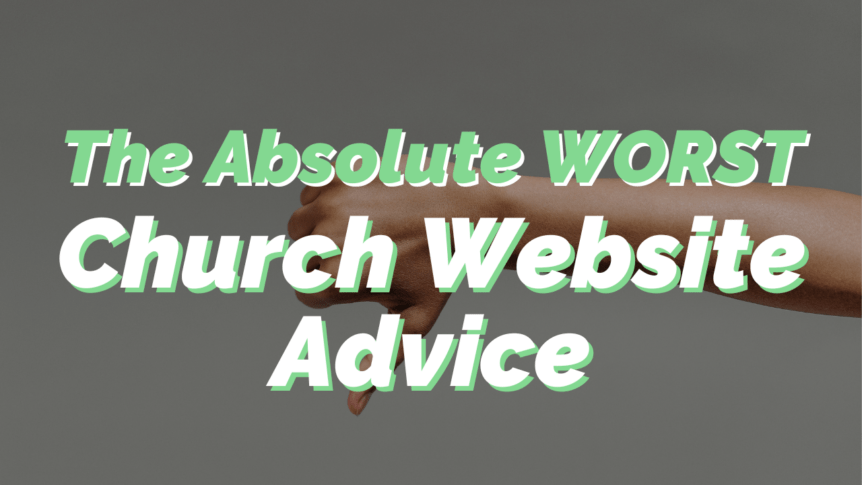Your webmaster told you what? Oh. No. He. Didn’t!
There is no shortage of terribly bad church website advice out there. We hear it every day. Some person who used to work in some tech field says that your website needs to do this and not do that.
Here’s the thing: what may have been good advice in 2008 might be a terrible idea today. In fact, some of those “great tips” might be hurting your website today.
Let’s walk through the bad church website advice that we hear most often. If you have to open a new tab make some changes to your site while you are reading, that’s okay too. We’ll cover the top 5 worst pieces of advice for church websites that you should change right now. Then, we’ll go over some good advice for your church website.
Sound good? Let’s jump in.
Estimated reading time: 11 minutes
Table of contents
Top 5 Worst Pieces of Advice for Church Websites

We almost all know a bad church website from a great church website. Maybe it has bad church website design, is confusing to navigate, or is just ugly to look at. Website visitors need an experience that is nice, comfortable, and clean. But that’s easier said than done.
There are a lot of common mistakes you and your team of website builders can make that could be hurting your website and its success. Let’s go over the top 5 worst pieces of advice for your church website. If you have any of these, you should start working on changing them today.
1. Let pictures do the talking
We have all heard that old adage that a picture is worth a thousand words. The right image can make an immediate emotional impact on a site visitor.
The problem is that when it comes to being found online the math doesn’t add up. Search engines are smarter than ever. They can pull information from pictures, but your church website still needs text content to rank on google.
We see a lot of sites that have almost no text content on the homepage. Google and other search engines will struggle to learn what your website is about. This will make it hard to recommend your site to searchers.
How much text should you have on your homepage? The more the better, as long as it is in keeping with your design. According to the search engine gurus at Yoast at a minimum, try to include at least 300 words.
2. Let your whole team manage the site
On the surface, this sounds like a good idea. Who doesn’t like to share the load of managing a whole website for a church?
Nearly every modern content management system allows you to set up multiple users to manage the site. So why not use this feature? Because there isn’t that much work to do and you are only adding complexity to your site. If you have a website set up properly and have one person trained to update the site, it shouldn’t take them more than a couple of hours per week. Even for a large church.
In talking with our clients we find that the average church of 500 spends about two hours per week working on their website. This includes uploading sermons, creating events and generally managing the content on the site. There are exceptions to this rule. If you have a church blog (you should), it is okay for all the writers to have access to the site. In WordPress, you would set them up in the “Author” role. For very large churches, with multiple technical staff members, there are exceptions to this rule. That being said, the vast majority of us should choose one person to run the site.
Train them. Give them the tools they need, and let them manage the site.
3. Use social media instead of a church website

If you haven’t heard, this whole social media thing is kind of a big deal. Your church needs to be using it to engage with your community. We recommend that churches use Facebook, and consider using Twitter and Instagram. There are great tools like Buffer to help you keep all your accounts straight and cut your admin time.
While you need to be on social media, it can’t be the center of your online presence. On social media, you don’t have home court advantage. Facebook does. They decide how far your posts go, who will see them, and you have limited control. In fact, your church’s social posts are not going nearly as far as they did a few years ago. It used to be when you posted on Facebook, your post went to everyone who liked your page. Today, unless you are willing to pay big bucks, your Facebook posts will only hit a fraction of your fans.
Don’t let them control the game. You need to have a home base where you make all the rules. Your website is that home base. One of your goals should be to get users on social media to make it over to your website so you can further engage them. Video and blogging are great ways to do just that.
4. Use your city and the word “church” over and over again
Search engines are smart today, but that wasn’t always the case.
Several years ago in church history, when you wanted to rank for a search engine term, you could just use it a lot on your site. Google would assume that you were the best result on that topic.
The problem was that with a little effort, someone could use a keyword over and over and cause a lot of trouble.
To get in on the action, some people have advised most churches to use this tactic to try to get their church in front of as many people as possible. They would tell churches to stuff their content with things like “Madison Church, Church Madison, Madison Churches, Churches in Madison, Church in Madison” and 50 other phrases with the same general meaning for search engine optimization.
This tactic used to work, and I don’t blame those who tried it. It was for a good cause. The problem is that today, all the major search engines are smart enough to detect this. If you get caught, the penalty is harsh. Your site will be demoted in the search rankings. Your website being the first impression for the vast majority of your visitors. If you aren’t on search engines, you are invisible to most people.
Your church can’t afford to take this risk. We still encourage you to optimize your web pages for search engines, but not to an extreme amount.
5. Make sure visitors hear your worship band
We know you love your worship team. They are awesome and are leading people into God’s presence.
Your community may well love your worship team too. In my experience, however, your worship time on Sunday rarely translates well to the web. Producing live music is an extremely technical process. It requires experience and equipment that few churches have. If you are wondering if your church has it, you probably don’t.
Like the old saying goes, you only have one chance to make a first impression. If someone’s first impression is a video filmed from the back of the church and direct audio from the soundboard, it will be a bad first impression. Even worse are those sites where music will auto-play when someone first gets onto the site. Nobody appreciates that.
If you don’t have the gear and talent to pull off live music recording well, keep your visitors in suspense. Your sermons are still great for the site. Voice recording is a much simpler task than trying to pull off music.
Good Advice for Church Websites

So that’s all the bad advice for church websites. Your church leaders and your team in charge of the online church side of things should stay clear of those. But what about some good advice? You know what you shouldn’t do, but what about what you should do?
Let’s find out.
1. Define Clear Goals
Before creating or updating your church website, it’s essential to establish clear goals. What do you want to achieve with your website? Are you looking to attract new visitors, keep current church members informed, or provide resources for spiritual growth? Defining these goals will guide every decision you make about the website’s design and content.
For instance, if one of your primary church website goals is to attract new visitors, ensure the homepage is welcoming and provides essential information like service time and location. If keeping church members informed is a priority, focus on having a clear and easy-to-navigate calendar of events. Whatever your goals, make sure they are front and center in your planning.
2. Keep Content Relevant and Engaging
The content on your church website should always be relevant and engaging to both new visitors and existing members. This includes regularly updating the website with fresh information, such as upcoming events, sermons, and news.
Your website’s content should also reflect the personality and values of your church. Include sections that tell visitors what your church believes, what your community is like, and how they can get involved. If possible, add testimonials or stories from church members to give a personal touch. Remember, people are often searching for a connection, so your content should help them feel welcome and informed.
3. Make Service Times and Location Easy to Find
One of the most critical pieces of information on your church website is the service times. This is often what visitors are looking for, so make sure this information is easy to find. Ideally, your service times should be prominently displayed on the homepage, perhaps at the top or in a sidebar, and should be easily accessible from any page on the site.
Additionally, include clear directions or a map to your church’s location. Some churches also find it helpful to include information about what to expect during a service, especially for first-time visitors. This could include dress code, parking details, or the style of worship. Making this information easily accessible helps reduce any anxiety visitors may have and makes them feel more comfortable attending.
4. Ensure the Website is Mobile-Friendly and Easy to Navigate
In today’s digital age, many people will access your church website from their smartphones or tablets. That’s why it’s crucial to ensure that your website is mobile-friendly. A mobile-friendly website automatically adjusts to fit the screen size of any device, making it easy to read and navigate, whether on a computer, tablet, or smartphone.
Additionally, your church website should be easy to navigate, with a clear menu and logical structure. Visitors should be able to find what they’re looking for, whether that’s service time, a calendar of events, or information about the church’s ministries, within just a few clicks. If your website is difficult to use or doesn’t load properly on mobile devices, you risk losing potential visitors who may look elsewhere.
Look at the website for Cornerstone Community Church. It looks great on a computer and on a mobile device. It’s also really simple and easy to navigate. No matter what device you’re on, you can read all the text you need to and get to the page you need to without breaking a sweat.
These four pieces of advice focus on making your church website a helpful and welcoming tool for both visitors and church members. By defining clear website goals, keeping the website’s content relevant, making service time easy to find, and ensuring the site is mobile-friendly, your church can create an online presence that truly reflects its mission and values.
Tired of Bad Church Website Advice?

We hope this list of what not to do has been helpful to you. The web remains one of the biggest opportunities for the Church. We will continue to write posts like these to help you improve your church site.
However, if you really want to take your church website to the next level, we can help.
We helped one small church of 50 people see over 300 first-time visitors in 2016. Nearly all of them found the church online.
Do you want to reach more people in your community? Do you want to see your church grow? Start getting serious about your web presence. Take advantage of our free church website strategy review.
What church website advice have you heard? Anything that we missed? Let us know on social media or in the comments below.




